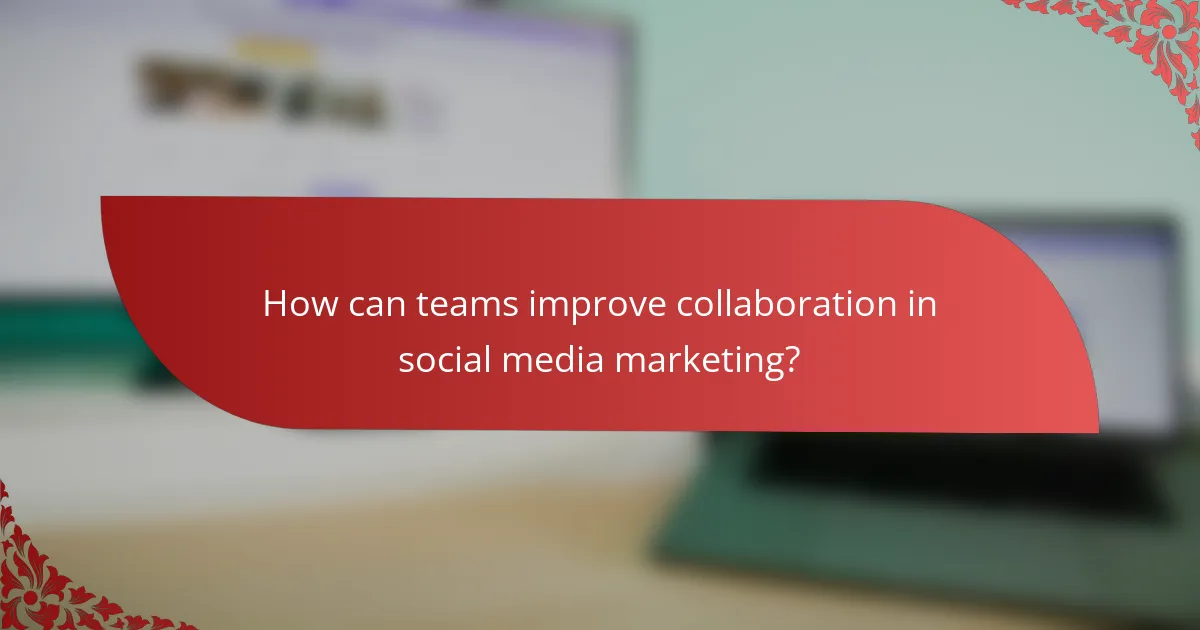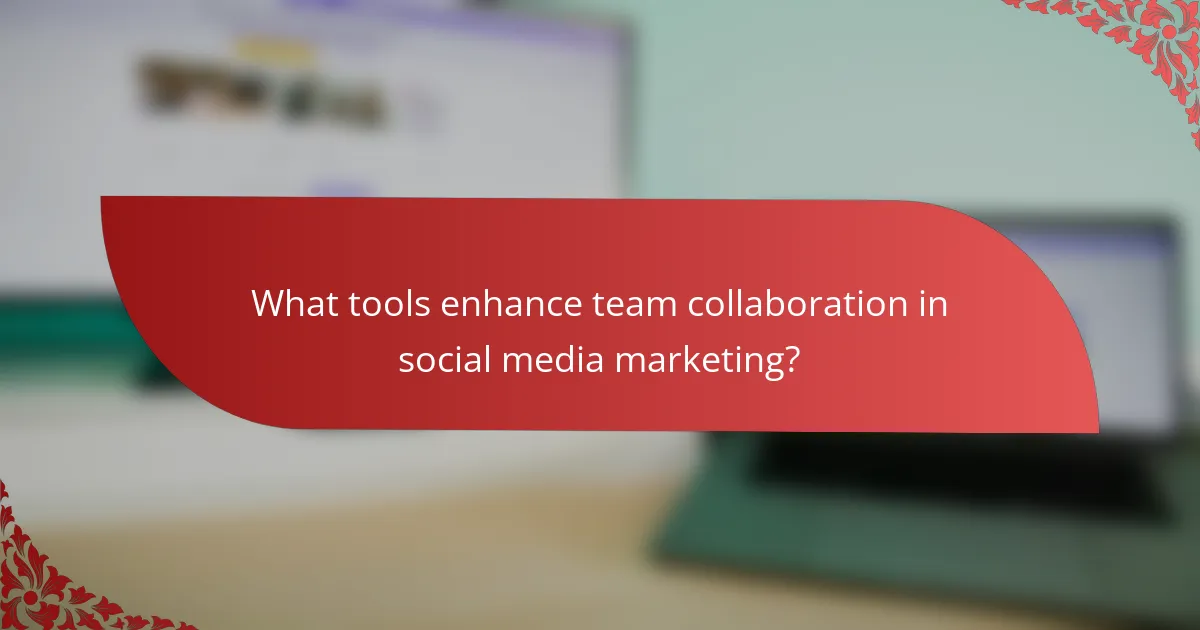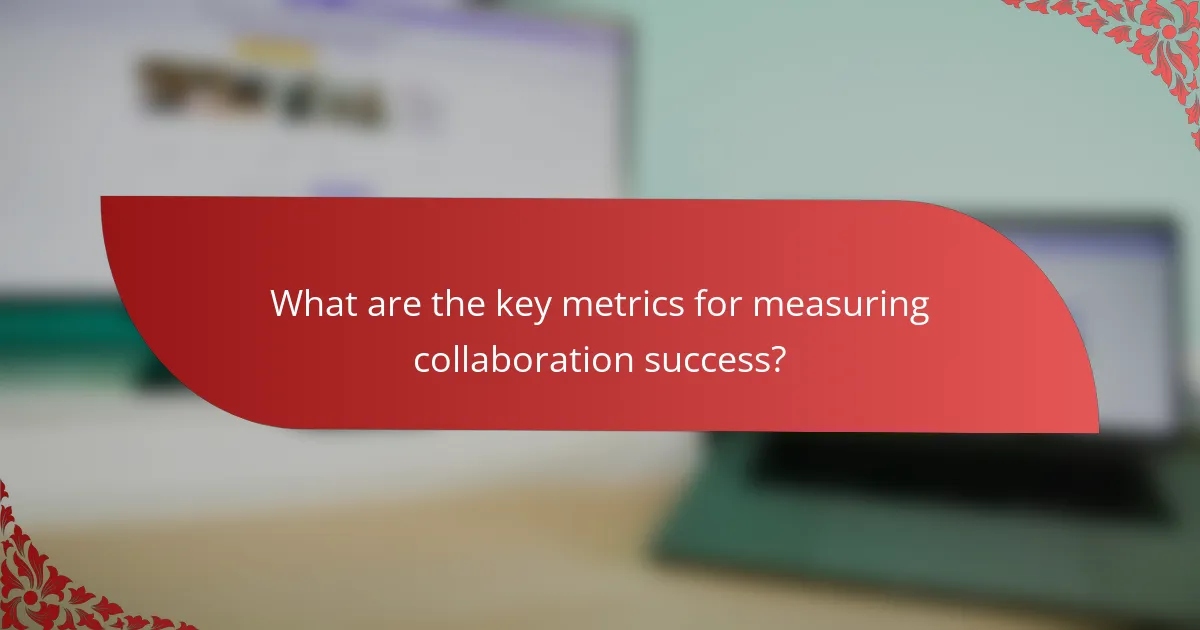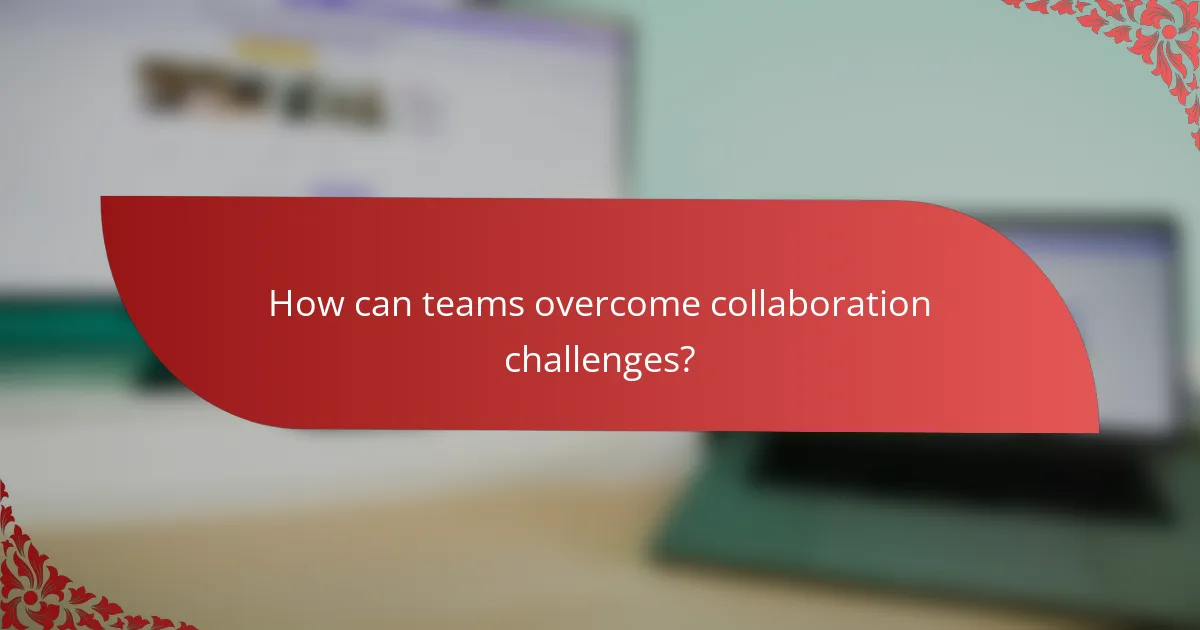This case study explores the dynamics of successful team collaboration in social media marketing, highlighting the importance of effective tools and structured processes. By focusing on clear objectives and streamlined communication, teams can enhance their creativity and productivity, ultimately leading to improved marketing outcomes. Key metrics such as engagement rates and team feedback will be examined to assess the effectiveness of collaborative efforts.

How can teams improve collaboration in social media marketing?
Teams can enhance collaboration in social media marketing by leveraging effective tools and practices that streamline communication and project management. By focusing on structured processes and clear objectives, teams can work more efficiently and creatively.
Utilizing project management tools like Asana
Project management tools such as Asana help teams organize tasks, set deadlines, and track progress in social media marketing campaigns. These platforms allow for task assignments, which ensures accountability and clarity on who is responsible for each aspect of the project.
Using Asana, teams can create project timelines and visualize workflows, making it easier to identify bottlenecks and adjust plans as needed. Regularly updating task statuses can keep everyone informed and aligned on project goals.
Implementing regular brainstorming sessions
Regular brainstorming sessions foster creativity and innovation within social media marketing teams. These meetings encourage team members to share ideas and collaborate on content strategies, campaign themes, and audience engagement tactics.
To maximize effectiveness, schedule these sessions at consistent intervals, such as bi-weekly or monthly. Utilize techniques like mind mapping or round-robin sharing to ensure all voices are heard and to stimulate diverse thinking.
Establishing clear communication channels
Clear communication channels are essential for effective collaboration in social media marketing. Teams should establish preferred platforms for different types of communication, such as instant messaging for quick questions and email for detailed discussions.
Consider using tools like Slack or Microsoft Teams to facilitate real-time communication. Regular check-ins can also help maintain alignment and address any issues promptly, preventing misunderstandings and delays.
Setting collaborative goals and KPIs
Collaborative goals and key performance indicators (KPIs) provide direction and measurable outcomes for social media marketing efforts. Setting shared objectives helps unify the team’s focus and encourages collective responsibility for achieving results.
When establishing goals, ensure they are specific, measurable, achievable, relevant, and time-bound (SMART). Regularly review these goals and KPIs to assess progress and make necessary adjustments to strategies.
Encouraging cross-departmental teamwork
Cross-departmental teamwork enhances collaboration by integrating diverse perspectives and expertise into social media marketing initiatives. Involving members from sales, customer service, and product development can lead to more comprehensive campaigns that resonate with target audiences.
To facilitate this collaboration, create opportunities for inter-departmental meetings or joint projects. This approach not only enriches content but also fosters a culture of teamwork across the organization, ultimately benefiting overall marketing efforts.

What tools enhance team collaboration in social media marketing?
Effective team collaboration in social media marketing relies on various tools that streamline communication, task management, and content scheduling. Utilizing the right tools can significantly improve productivity and ensure that all team members are aligned with the marketing strategy.
Trello for task management
Trello is a visual project management tool that helps teams organize tasks and track progress. By using boards, lists, and cards, team members can assign responsibilities, set deadlines, and monitor the status of various social media campaigns.
To maximize Trello’s effectiveness, create a dedicated board for each campaign and use labels to categorize tasks by priority or type. Regularly updating the board keeps everyone informed and accountable.
Slack for real-time communication
Slack is a messaging platform that facilitates instant communication among team members. With channels dedicated to specific projects or topics, Slack allows for focused discussions and quick feedback, which is essential in the fast-paced world of social media marketing.
To enhance collaboration, integrate Slack with other tools like Trello or Google Workspace. This allows team members to receive updates and notifications directly within Slack, reducing the need to switch between applications.
Hootsuite for social media scheduling
Hootsuite is a comprehensive social media management tool that enables teams to schedule posts across multiple platforms from a single dashboard. This feature saves time and ensures a consistent posting schedule, which is crucial for audience engagement.
When using Hootsuite, plan your content calendar in advance and utilize the analytics features to track performance. Adjust your strategy based on engagement metrics to optimize future posts.
Google Workspace for document sharing
Google Workspace provides a suite of tools for document creation, sharing, and collaboration. With Google Docs, Sheets, and Drive, team members can work together in real-time, making it easy to draft content, analyze data, and store important files.
To ensure smooth collaboration, establish clear naming conventions for documents and maintain organized folders. Encourage team members to leave comments and suggestions directly within the documents for efficient feedback and revisions.

What are the key metrics for measuring collaboration success?
Key metrics for measuring collaboration success in social media marketing include engagement rates, team productivity, and feedback from team members. These metrics provide insights into how effectively a team works together and the impact of their collaborative efforts on overall performance.
Engagement rates on social media posts
Engagement rates reflect how well content resonates with the audience, typically measured by likes, shares, comments, and overall interactions. A good engagement rate often falls between 1% to 5% for most platforms, but this can vary based on industry and audience size.
To assess collaboration success, compare engagement rates before and after implementing team strategies. For instance, if a coordinated campaign results in a 30% increase in interactions, it indicates effective teamwork and content alignment.
Team productivity metrics
Team productivity metrics can include the number of posts created, the speed of content delivery, and adherence to deadlines. Tracking these metrics helps identify how efficiently team members collaborate and manage their tasks.
Using project management tools can facilitate monitoring productivity. For example, if a team consistently meets deadlines and increases output by 20% during a campaign, it suggests successful collaboration and resource allocation.
Feedback from team members
Feedback from team members provides qualitative insights into the collaboration process. Regular check-ins or surveys can help gauge team morale, communication effectiveness, and perceived challenges.
Encouraging open dialogue about collaboration experiences can reveal areas for improvement. For example, if team members express concerns about communication tools, addressing these issues can enhance future collaboration efforts and overall team satisfaction.

What challenges do teams face in social media marketing collaboration?
Teams in social media marketing often encounter various challenges that can hinder effective collaboration. Key issues include miscommunication, misalignment of goals, and time zone differences, particularly for remote teams.
Miscommunication among team members
Miscommunication is a common challenge that can lead to confusion and errors in social media marketing campaigns. When team members do not clearly convey their ideas or feedback, it can result in inconsistent messaging and branding.
To mitigate miscommunication, teams should establish clear communication channels and protocols. Regular check-ins and updates can help ensure everyone is on the same page, reducing the likelihood of misunderstandings.
Difficulty in aligning goals
Aligning goals across different team members can be challenging, especially when individuals have varying priorities or perspectives. Without a unified vision, social media campaigns may lack coherence and fail to achieve desired outcomes.
To foster goal alignment, teams should engage in collaborative planning sessions where everyone can contribute their insights. Setting measurable objectives and key performance indicators (KPIs) can also help maintain focus and track progress effectively.
Time zone differences in remote teams
Time zone differences pose significant challenges for remote teams working on social media marketing. Coordinating meetings and deadlines can become complicated, leading to delays in project execution.
To address this issue, teams can adopt flexible scheduling practices, such as rotating meeting times to accommodate all members. Utilizing project management tools that allow for asynchronous collaboration can also help keep everyone informed and engaged, regardless of their location.

How can teams overcome collaboration challenges?
Teams can overcome collaboration challenges by establishing clear communication channels and fostering a culture of accountability. Implementing structured processes and regular interactions can significantly enhance teamwork and project outcomes.
Regular check-ins and updates
Regular check-ins and updates are essential for maintaining alignment among team members. These meetings, whether daily or weekly, provide opportunities to discuss progress, address obstacles, and adjust strategies as needed.
Consider using tools like video conferencing or project management software to facilitate these check-ins. Aim for brief sessions, typically lasting 15-30 minutes, to keep discussions focused and efficient.
To maximize effectiveness, establish a routine agenda that includes updates on individual tasks, feedback on recent work, and a review of upcoming deadlines. This structure helps ensure that all team members are informed and engaged, reducing the likelihood of miscommunication.
